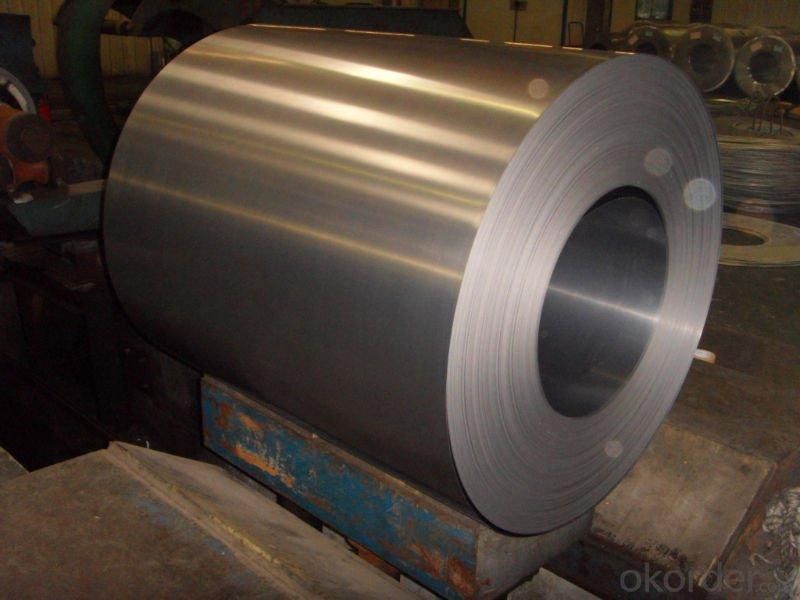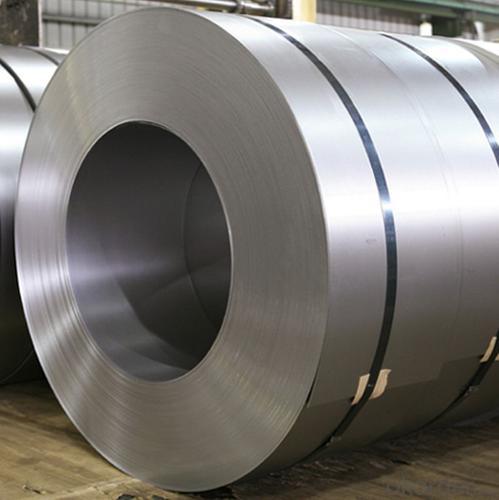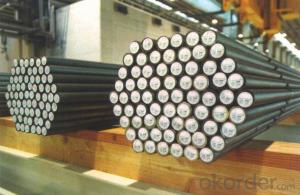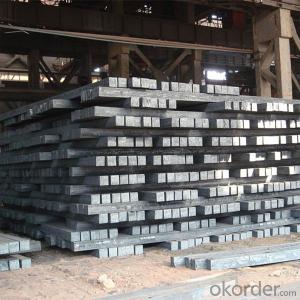Supply For Silicon Steel and Electric Steel
- Loading Port:
- Shanghai
- Payment Terms:
- TT OR LC
- Min Order Qty:
- 50 kg
- Supply Capability:
- 4000 kg/month
OKorder Service Pledge
OKorder Financial Service
You Might Also Like
1.Description:
Silicon steel containing silicon content is 0.5 to 4.5% of very low carbon ferrosilicon alloy, due to the different structure and use is divided into non oriented silicon steel and grain oriented silicon steel. Silicon steel is mainly used for motors, generators, compressors, motors and transformers core, is the electric, home appliances and other industries indispensable raw materials products.
Silicon steel sheets cold rolling, hot-rolled two, the use of more cold-rolled silicon steel sheet. Cold-rolled silicon steel sheet along the rolling direction with excellent magnetic properties, not only in the strong magnetic field has high saturation magnetic flux density and low loss, but also have good magnetic properties (initial permeability) in the weak magnetic field. Because of the cold rolling process, the impurity content of the steel sheet is decreased, and the coarse grain is caused, and the magnetic permeability is increased and the hysteresis loss decreases.
2.Product characteristic:
The main requirements for the silicon steel properties are:
1, low iron loss, this is the most important quality index of silicon steel sheet. All core loss grades according to the lower grades, the iron loss, the higher.
2, a strong magnetic field of magnetic induction (magnetic), which makes the motor and transformer core volume and weight, saving silicon steel, copper and insulating materials, etc..
3, the surface is smooth, flat and thickness uniformity, can improve the core fill factor.
4, good film, for manufacturing micro, small motor is more important.
5, the adhesion and welding of the surface insulation film is good, can prevent and improve the film.
3.Specifications :
Material: B50A470
0.5*1200*C, 0.5*1000*C
4.Reference picture:




Material: B50A470
Origin / manufacturer :Shanghai Baoshan Iron & Steel Co.
Stock:Jiayin Stock
Specifications :0.5*1200*C, 0.5*1000*C
- Q: What are the factors affecting the core loss in silicon steel?
- The factors affecting the core loss in silicon steel include the frequency of the alternating magnetic field, the thickness and quality of the steel laminations, the magnetic properties of the steel material, and the design of the transformer or electrical device in which the silicon steel is used. Additionally, factors such as temperature, grain orientation, and impurities in the steel can also impact the core loss.
- Q: What is the effect of mechanical vibrations on the magnetic properties of silicon steel?
- Mechanical vibrations can have a significant effect on the magnetic properties of silicon steel. Silicon steel is a ferromagnetic material commonly used in electrical transformers, motors, and generators due to its ability to efficiently conduct magnetic flux. However, when subjected to mechanical vibrations, the magnetic properties of silicon steel can be altered. One of the primary effects of mechanical vibrations on silicon steel is the introduction of mechanical stress. Vibrations can cause the material to experience varying levels of stress, which can lead to changes in the crystal structure of the steel. These structural changes can disrupt the alignment of magnetic domains within the material, affecting its overall magnetic properties. Additionally, vibrations can also induce eddy currents in the silicon steel. Eddy currents are circulating currents that are generated in a conductor when it is exposed to a changing magnetic field. The presence of these eddy currents can lead to the dissipation of energy in the form of heat, resulting in increased resistive losses in the silicon steel. This can cause a decrease in the efficiency of electrical devices that rely on silicon steel for their magnetic properties. Furthermore, vibrations can also cause mechanical fatigue in silicon steel. Continuous mechanical stress can lead to the formation of microcracks or structural defects within the material. These defects can disrupt the flow of magnetic flux and reduce the overall magnetic permeability of the silicon steel. As a result, the material may exhibit decreased magnetic properties and reduced performance in magnetic applications. In conclusion, mechanical vibrations can have a detrimental effect on the magnetic properties of silicon steel. The introduction of mechanical stress, the generation of eddy currents, and the occurrence of mechanical fatigue can all lead to changes in the material's magnetic behavior. Therefore, it is important to consider and mitigate the effects of vibrations when designing and operating devices that utilize silicon steel for its magnetic properties.
- Q: How does the surface treatment of silicon steel affect its wear resistance?
- The wear resistance of silicon steel greatly depends on its surface treatment. Silicon steel, which is a type of steel alloy containing a substantial amount of silicon, is known for its magnetic properties and suitability for use in electrical and power transformer cores. When considering wear resistance, the surface treatment of silicon steel can either greatly improve or deteriorate its performance. One common method of surface treatment is applying a protective coating, such as a thin layer of zinc or other corrosion-resistant materials. This coating acts as a barrier between the steel and its surroundings, shielding it from corrosion, oxidation, and abrasive wear. Applying a protective coating on silicon steel enhances its wear resistance by reducing contact between the steel surface and external elements that can cause wear. It also helps prevent the formation of surface defects like scratches, dents, or cracks, which can accelerate wear and decrease the steel's lifespan. Moreover, surface treatments like nitriding or carburizing can be used to create a hardened layer on silicon steel. These treatments involve introducing nitrogen or carbon atoms into the steel's surface, resulting in a harder and more wear-resistant outer layer. This hardened layer significantly improves the steel's resistance to abrasive wear, making it suitable for applications involving sliding or rubbing contact with other materials. On the other hand, improper or inadequate surface treatment can have a negative impact on the wear resistance of silicon steel. If the surface treatment is not applied correctly or if the protective coating is of low quality, it can lead to premature wear and corrosion of the steel. Exposure to moisture, chemicals, or other environmental factors can degrade the coating, exposing the steel to wear and reducing its overall lifespan. In conclusion, the wear resistance of silicon steel is determined by its surface treatment. Proper surface treatment, such as applying protective coatings or creating hardened surface layers, can significantly enhance its wear resistance. However, inadequate or improper surface treatment can result in accelerated wear and corrosion, diminishing the steel's lifespan and overall performance.
- Q: What are the disadvantages of using silicon steel?
- There are several disadvantages of using silicon steel, also known as electrical steel, in various applications. Firstly, silicon steel is relatively expensive compared to other types of steel. This is primarily due to the high cost of silicon, which is added to the steel to improve its electrical properties. The added cost can make it less economically viable for certain applications where cost-effectiveness is a crucial factor. Secondly, silicon steel is prone to rust and corrosion. Although it possesses good magnetic properties, its susceptibility to oxidation can limit its usage in certain environments. This makes it necessary to apply protective coatings or treatments to prevent rusting and maintain its performance. Another significant disadvantage of silicon steel is its brittleness. It tends to be more brittle than other types of steel, which can make it more susceptible to cracking or breaking under mechanical stress. This restricts its use in applications that require high flexibility or resistance to impact. Additionally, silicon steel has limitations when it comes to high-frequency applications. Due to its magnetic properties, silicon steel exhibits increased eddy current losses at high frequencies, leading to energy wastage and reduced efficiency. As a result, it may not be suitable for applications that require high-frequency operation, such as certain electrical transformers or inductors. Moreover, the production of silicon steel involves complex manufacturing processes, which require specific techniques and equipment. This can further contribute to its higher cost and limited availability compared to other types of steel. In conclusion, while silicon steel offers excellent electrical properties and magnetic characteristics, it also has several disadvantages that need to be considered. These include its relatively high cost, susceptibility to rust and corrosion, brittleness, limitations in high-frequency applications, and the complexity of its manufacturing processes.
- Q: How can the silicon steel sheet of transformer be disassembled completely?
- After stripping the outer insulation, picked up the transformer, using a hammer or pliers pounding on the silicon steel sheet, the whole wafer detachment, then using a pointed nose pliers pull in the outer layer, percussion, as steel sheet will naturally fall.
- Q: What is the effect of magnetic field amplitude on the magnetic properties of silicon steel?
- The effect of magnetic field amplitude on the magnetic properties of silicon steel is that it determines the level of magnetization and the resulting magnetic behavior. As the magnetic field amplitude increases, the silicon steel becomes more magnetized and exhibits stronger magnetic properties. This increase in magnetization leads to improved magnetic permeability, lower hysteresis losses, and enhanced magnetic efficiency in silicon steel applications.
- Q: How does the presence of non-magnetic phases affect the magnetic properties of silicon steel?
- The presence of non-magnetic phases in silicon steel can significantly affect its magnetic properties. These non-magnetic phases, such as oxides and carbides, can disrupt the alignment of magnetic domains, reducing the overall magnetic permeability and saturation magnetization of the material. This leads to a decrease in the magnetic induction and hysteresis losses, making the silicon steel less efficient for applications requiring high magnetic performance. Therefore, minimizing the presence of non-magnetic phases is crucial to optimize the magnetic properties of silicon steel.
- Q: How is silicon steel produced?
- Silicon steel, also known as electrical steel or transformer steel, is produced through a process called grain-oriented electrical steel (GOES) production. The production of silicon steel involves several steps. The first step is the melting of iron, which is usually done in a blast furnace. Iron ore, along with other materials such as coke and limestone, is heated at high temperatures to form liquid iron. The impurities are then removed from the molten iron through a process called refining. Next, silicon is added to the molten iron to achieve the desired silicon content. Silicon is a key component in silicon steel, as it helps in increasing its electrical resistivity and reducing energy losses. The addition of silicon is carefully controlled to achieve the desired magnetic properties of the final product. After the silicon is added, the molten iron is poured into thin slabs or cast into thin sheets, depending on the desired final product. These slabs or sheets are then rolled at high temperatures to reduce their thickness and improve their mechanical properties. This process is known as hot rolling. Once the desired thickness is achieved, the silicon steel is then subjected to a process called annealing. Annealing involves heating the steel to a specific temperature and then cooling it slowly to relieve internal stresses and improve the grain structure. This process enhances the magnetic properties of the silicon steel, making it suitable for electrical applications. After annealing, the silicon steel is coated with an insulating material to prevent the occurrence of eddy currents, which can result in energy losses. The coating is usually made of an organic material such as varnish or an inorganic material such as oxide. Finally, the silicon steel is cut into the desired shapes and sizes to be used in various electrical applications such as transformers, motors, and generators. In summary, the production of silicon steel involves melting iron in a blast furnace, adding silicon to achieve the desired properties, casting or rolling the molten iron into thin sheets, annealing to enhance magnetic properties, coating to prevent energy losses, and finally cutting into the desired shapes and sizes. The entire process is carefully controlled to ensure the production of high-quality silicon steel with excellent electrical characteristics.
- Q: What is the effect of frequency on the magnetic properties of silicon steel?
- The effect of frequency on the magnetic properties of silicon steel can be significant. Silicon steel is a widely used material in electrical engineering and power systems due to its high magnetic permeability and low core losses. The magnetic properties of silicon steel, including its magnetic permeability and hysteresis, can be influenced by the frequency at which it is subjected to a magnetic field. At low frequencies, the magnetic permeability of silicon steel is relatively high. This means that it can easily magnetize and demagnetize when exposed to a varying magnetic field. Silicon steel is commonly used in transformers and other electrical devices that operate at low frequencies, as it efficiently transfers and amplifies magnetic energy. However, as the frequency increases, the magnetic properties of silicon steel start to change. At higher frequencies, the magnetic permeability of silicon steel decreases, leading to increased core losses. This is due to the eddy currents that are induced in the material as a result of the changing magnetic field. These eddy currents generate heat and dissipate energy, resulting in increased losses and reduced efficiency. To mitigate this effect, silicon steel is often laminated to minimize the formation of eddy currents. By creating thin layers of silicon steel separated by insulation, the flow of eddy currents is disrupted, reducing the core losses and improving the overall magnetic performance of the material at higher frequencies. In conclusion, the frequency at which silicon steel is subjected to a magnetic field has a significant effect on its magnetic properties. While silicon steel exhibits high magnetic permeability and low core losses at low frequencies, its performance deteriorates as the frequency increases due to the formation of eddy currents. By laminating the material, the negative effects of higher frequencies can be minimized, ensuring optimal magnetic performance in electrical devices and power systems.
- Q: What are the main alloying elements in silicon steel?
- The main alloying elements in silicon steel are silicon and carbon. Silicon is added to steel to increase its electrical resistivity and magnetic permeability, making it suitable for use in electrical transformers and motors. Carbon is added to improve the strength and hardness of the steel. Other alloying elements that may be present in smaller quantities include manganese, phosphorus, and sulfur, which can affect the steel's properties such as ductility and corrosion resistance. Silicon steel is also known as electrical steel or transformer steel due to its excellent magnetic properties.
Send your message to us
Supply For Silicon Steel and Electric Steel
- Loading Port:
- Shanghai
- Payment Terms:
- TT OR LC
- Min Order Qty:
- 50 kg
- Supply Capability:
- 4000 kg/month
OKorder Service Pledge
OKorder Financial Service
Similar products
Hot Searches






















